Underfloor heating has become one of the most popular methods for creating comfortable, energy-efficient homes across the UK. By gently warming the entire floor surface, it provides a luxurious, evenly distributed heat that radiates upwards – eliminating cold spots and chilly mornings.
However, deciding to install underfloor heating isn’t as simple as switching your radiators for something new. Because the system is installed beneath your flooring, it must be planned before you lay new floors or begin major renovation work. Early preparation ensures that the system performs efficiently and integrates seamlessly with your chosen floor finish.
At Heath Electrical Services, our experienced electricians in Milton Keynes and Leighton Buzzard have been helping homeowners, landlords, and commercial clients design and install safe, reliable heating systems for many years. As NICEIC-approved and ECA-accredited contractors, we deliver professional installations that meet the latest UK standards – giving you peace of mind that your underfloor heating will perform safely and efficiently for years to come.
In this comprehensive guide, we’ll cover everything you need to know before installing underfloor heating – how it works, whether it’s expensive to run, if it’s worth it, and the installation and maintenance process.
A guide to installing underfloor heating
Underfloor heating (UFH) is a system that provides warmth by circulating heat beneath the floor surface rather than through traditional radiators. This gentle, radiant heat creates a more consistent temperature throughout your home, improving comfort and energy efficiency.
There are two main types of underfloor heating:
- Electric (dry) systems, which use heating cables or mats powered by electricity.
- Water-based (wet) systems, which circulate warm water through pipes connected to your boiler or heat pump.
In the sections below, we’ll explain:
- How does underfloor heating work?
- Is underfloor heating expensive to run?
- Is underfloor heating worth it?
- How long does underfloor heating take to warm up?
- How to install underfloor heating
- How to bleed underfloor heating
Each section will give you a practical understanding of how these systems function, what to expect in terms of performance, and how professional installation by Heath Electrical Services ensures the best results.
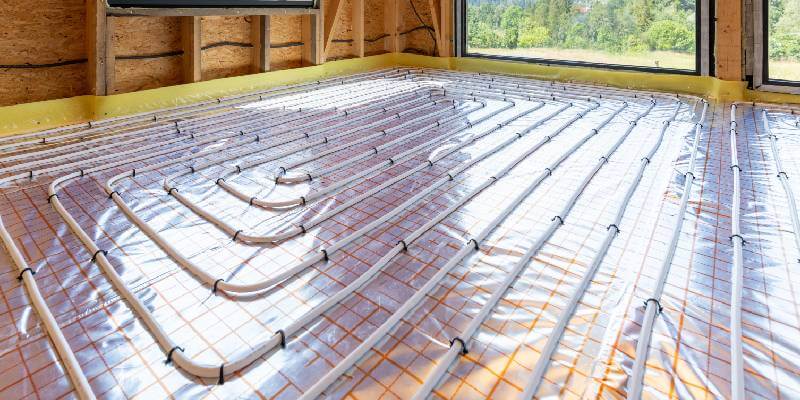
How does underfloor heating work?
Underfloor heating works by evenly distributing heat across the entire floor area. Depending on the system type, this is achieved through either warm water pipes or electric heating cables embedded beneath the floor surface.
When the system is turned on, the floor gently warms up, radiating heat upwards into the room. This method of radiant heating ensures a more consistent and natural warmth compared to the convection heat produced by radiators, which can cause uneven temperatures.
For water-based systems, a central manifold controls the temperature and distributes warm water from your boiler or heat pump through a network of pipes. These systems are particularly efficient when paired with a heat pump, as they operate better at lower water temperatures.
Electric underfloor heating systems, on the other hand, use electric cables or heating mats connected to a thermostat, allowing for precise control and quick heat-up times.
Whether you choose a water or electric system, the key to long-lasting performance lies in professional installation. At Heath Electrical Services, our NICEIC-approved electricians in Milton Keynes and Leighton Buzzard ensure your system is correctly designed, safely connected, and fully compliant with current UK wiring regulations.
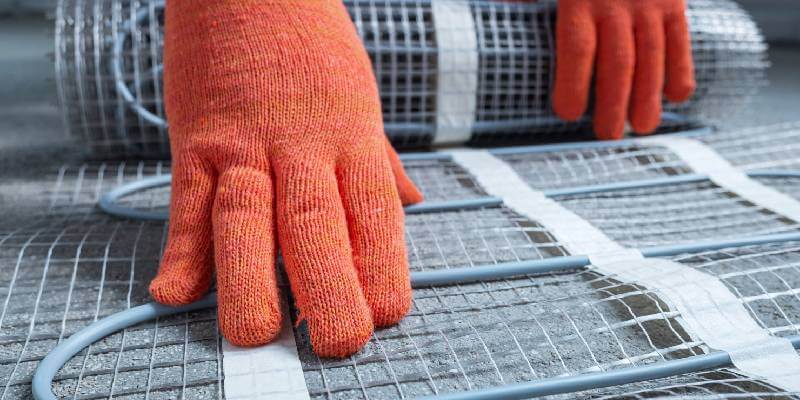
Is underfloor heating expensive to run?
Underfloor heating isn’t necessarily expensive to run – its efficiency and cost depend on several factors, including the system type, insulation quality, energy tariffs, and how you use it. In many cases, it’s more energy-efficient than traditional radiators because it covers a larger area at a lower temperature.
Factors influencing running costs
- System type: Water-based systems are generally cheaper to run because they use your boiler’s hot water or heat pump energy, which can be more economical than electricity.
Electric systems may have higher running costs due to electricity prices, but they can be highly efficient in smaller spaces or well-insulated homes. - Home insulation: A well-insulated home retains heat longer, reducing the energy needed to maintain comfort. Investing in insulation for walls, floors, and ceilings significantly improves efficiency.
- Energy tariffs: The cost of electricity and gas varies between providers, so switching to an energy-efficient tariff can make a noticeable difference to running costs.
- Usage and control: Smart thermostats and timers allow you to run underfloor heating only when needed, maintaining comfort without wasting energy.
- Room size and placement: Larger spaces require more energy, so zoning your heating system (heating only specific areas at a time) can be an effective way to save money.
Efficiency advantages
- Lower operating temperatures: UFH runs at around 30–50°C compared to radiators that operate at 60–75°C. This means less energy is required to achieve the same comfort level.
- Even heat distribution: With warmth spread evenly from the ground up, the system avoids the inefficiencies of hot and cold spots, maintaining consistent comfort.
Tips for lowering costs
- Choose a water-based system for large areas or new builds.
- Improve your home insulation to reduce heat loss.
- Use programmable thermostats for better temperature control.
- Pair your system with a heat pump for maximum efficiency.
For more energy-saving advice, visit The Energy Saving Trust’s guide to underfloor heating.
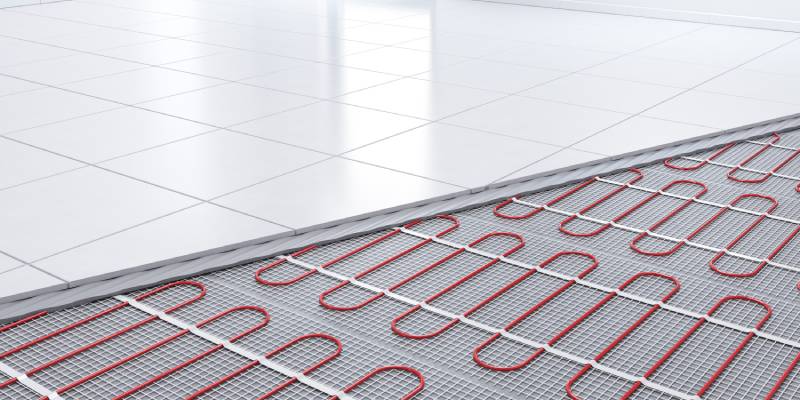
Is underfloor heating worth it?
Yes, underfloor heating is often worth the investment. While the upfront cost can be higher than installing traditional radiators, the long-term energy savings, comfort, and aesthetic benefits make it an attractive option for homeowners and landlords alike.
Benefits
- Energy efficiency: Underfloor heating works at lower temperatures, saving energy and reducing heating bills. When paired with renewable systems like heat pumps, it can be 15–40% cheaper to run.
- Consistent comfort: Radiant heat eliminates cold spots and draughts, maintaining a steady, comfortable warmth throughout your home.
- Design freedom: No radiators mean more usable wall space for furniture and décor.
- Health benefits: UFH can help reduce dust circulation, which may benefit those with allergies or asthma.
- Increased property value: As a sought-after luxury feature, underfloor heating can make your property more attractive to buyers.
- Long lifespan: When installed correctly, underfloor heating can last for decades with minimal maintenance.
Considerations
- Upfront cost: Installation can be more expensive than radiators, particularly for retrofits.
- Slow to heat up: Especially for water systems, it may take longer to reach the desired temperature.
- Installation quality: Poor installation can affect performance, so always use qualified professionals like Heath Electrical Services.
- Property condition: Homes with very poor insulation (EPC rating E or lower) may not fully benefit until insulation is improved. Learn more about EPC ratings at GOV.UK
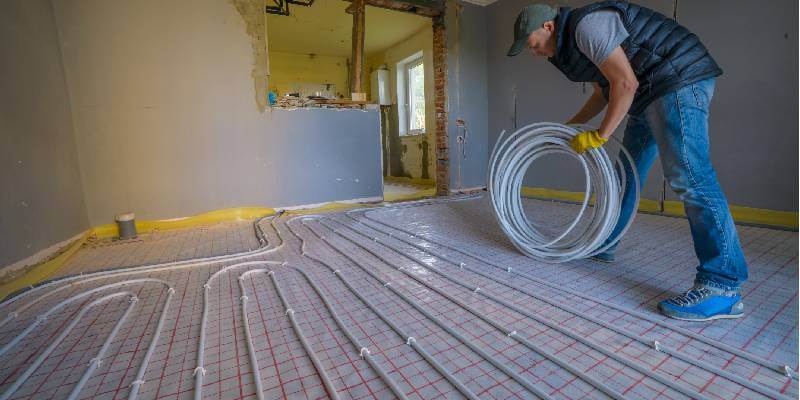
How long does underfloor heating take to warm up?
The time it takes for an underfloor heating system to warm up can vary quite a bit depending on the system type, floor materials, and the overall insulation of your property. In most cases, electric systems heat up more quickly, reaching a comfortable temperature in around 30 minutes to 2 hours, while water-based systems (especially those embedded in a screed) can take 2 to 4 hours or more to reach optimal warmth. Although water systems take longer initially, they tend to retain heat for much longer, making them a more efficient option for sustained use.
Factors that influence heat-up time
- Type of system: Electric underfloor heating typically responds faster because the heating elements sit directly beneath the floor surface. In contrast, water-based systems heat up more slowly as warm water circulates through pipes buried within a concrete screed.
- Insulation quality: A well-insulated subfloor prevents heat loss into the ground, helping your system warm up more efficiently. Without adequate insulation, much of the generated heat can escape downward rather than into your living space.
- Floor covering: The type of flooring above your heating system has a major impact on response time. Hard surfaces like tile and stone transfer heat quickly, while thicker materials such as carpet or wood can slow down heat distribution.
- System power or flow rate: Higher wattage electric systems or increased water flow rates in wet systems allow for faster heat-up times — though these settings must always be balanced for efficiency and safety.
- Room size: Larger rooms naturally take longer to heat as there’s more air volume and floor area for the system to warm up. Smaller, well-insulated rooms will feel the effects of underfloor heating much sooner.
Tips for managing heat-up time
- Use a programmable thermostat: Setting your thermostat to activate your underfloor heating in advance ensures the room is perfectly warm when you need it. For instance, if your system typically takes an hour to reach a comfortable temperature, set it to switch on an hour before you plan to use the space. Smart thermostats — such as those recommended by The Energy Saving Trust
- Maintain consistent warmth: It’s often more efficient to keep your underfloor heating running at a low, steady temperature rather than turning it off completely between uses. Reheating a cold system consumes more energy than maintaining a consistent baseline warmth.
- Improve insulation: Investing in quality insulation beneath your floor and throughout your property will shorten warm-up times and help your heating system work more effectively — a step that also supports overall energy efficiency.
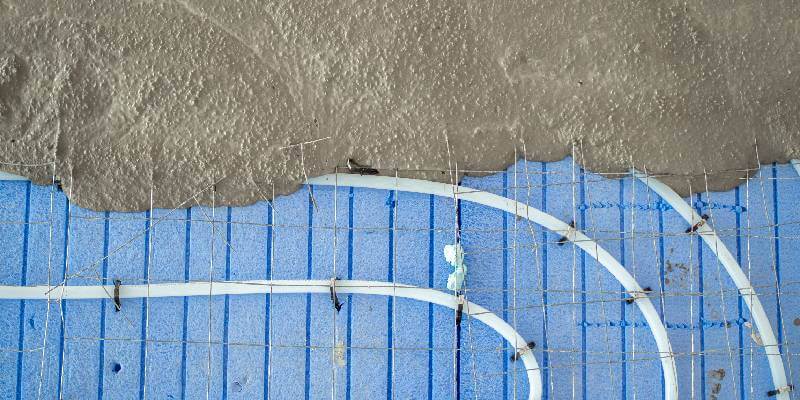
How to install underfloor heating
Installing underfloor heating involves careful preparation and expertise to ensure safety and efficiency.
The process typically includes:
- Preparing the subfloor: Insulation boards or layers are installed to prevent heat loss and improve system efficiency.
- Laying the heating elements: Electric systems use heating mats or wires positioned evenly across the floor.
Water systems use PEX pipes connected to a manifold that distributes hot water. - Connecting the system: Electric cables are safely connected to the mains and thermostats by a qualified electrician. Water pipes are connected to the boiler or heat pump via the manifold.
- Adding the floor covering: Once installed and tested, the system is covered with screed or cement boards before laying the final flooring.
Because underfloor heating involves complex electrical and plumbing work, professional installation is essential. At Heath Electrical Services, our expert electricians in Leighton Buzzard and Milton Keynes ensure every system is fitted to meet current regulations and manufacturer specifications.
Our team can advise you on system design, floor compatibility, and ongoing maintenance, ensuring you get the best performance and longevity from your installation.
For technical standards, refer to CIBSE’s guidance on heating systems.
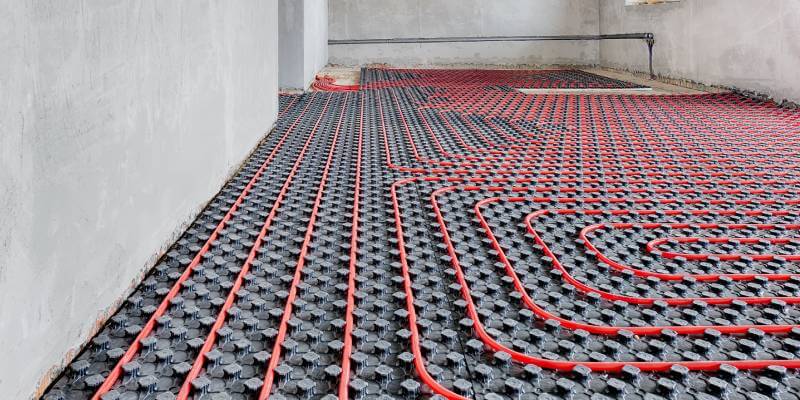
How to bleed underfloor heating
Bleeding is a maintenance process used to remove trapped air from water-based underfloor heating systems. (Note: Electric systems do not require bleeding.)
Signs your system needs bleeding
- Strange noises like hissing, gurgling, or bubbling coming from the pipes.
- Uneven heating, with warm and cold patches across the floor.
- No heat output in certain areas.
These symptoms occur because air bubbles block the flow of hot water through the system, reducing efficiency.
How to bleed the system
- Turn off the heating: Allow the system to cool before starting.
- Open each zone valve: Start from the lowest floor in your property and work upwards.
- Bleed each valve: Use a radiator key to open each valve until you see water and air escaping.
Have a towel and bowl ready to catch water. - Flush the manifold: Attach a hosepipe to the top manifold and open the drain valve on the lower manifold. Flush each loop in turn to remove trapped air.
- Check pressure: Once complete, check the system pressure and top up with water if needed.
If you’re unsure or uncomfortable performing this task, always seek help from a qualified professional. The Heath Electrical Services team can safely carry out system bleeding, maintenance, and inspections to restore full performance and efficiency.
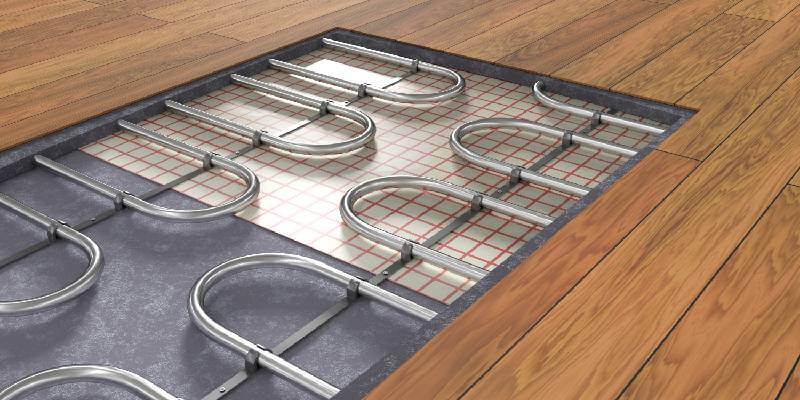
Enjoy year-round comfort with Heath Electrical Services
Underfloor heating offers a modern, efficient, and comfortable way to heat your home or business. With the right design, professional installation, and proper maintenance, it can provide long-term savings and a luxurious living environment.
At Heath Electrical Services, we combine decades of experience with industry-leading accreditations to deliver high-quality underfloor heating installations across Milton Keynes, Leighton Buzzard, and the surrounding areas. Whether you’re renovating your home, upgrading a rental property, or fitting out a new commercial space, our NICEIC-approved electricians will ensure your system is designed and installed to the highest standards.
If you’re considering underfloor heating or want to discuss your options, contact our friendly team today. Our expert electricians in Milton Keynes and Leighton Buzzard are here to help you enjoy efficient, comfortable warmth all year round.













